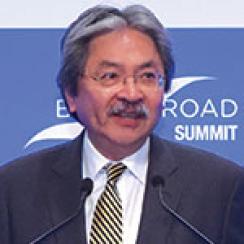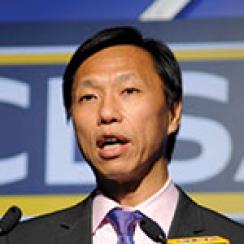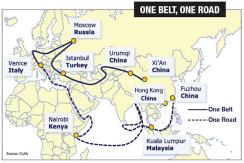To view a PDF of the report, click here.
By Tanya Angerer
China’s slowdown is affecting markets around the world--and few economies are more closely linked to the ups and downs of Chinese growth than Hong Kong, as a traditional hub for China’s inbound and outbound investment. Last year, 68 percent of foreign direct investment in China, worth $126 billion, flowed through Hong Kong. Figures from the Hong Kong Monetary Authority show overseas investment by Chinese firms in 2014 stood at $123 billion, with 58 per cent going via Hong Kong.

| 
|
| John Tsang Financial Secretary of Hong Kong | Francis Cheung, head of China-HK Strategy, CLSA in Hong Kong |
| “With our close ties with the mainland, our ready access to Asian markets, as well as our wide-ranging prowess as Asia’s international financial center, I believe that no economy is better-placed than Hong Kong to serve as the center for fundraising, for project financing and asset management for big-ticket infrastructure projects.’’ | “China doesn’t really have an established international financing center yet, especially due to its capital controls. Their bond markets domestically are young so it makes a lot of sense to set up the Belt, Road project financing in Hong Kong because it’s free of capital controls.” |
John Tsang, Hong Kong’s Financial Secretary, tells Institutional Investor in an interview why Hong Kong is ideal to play a key fundraising role for this vast initiative.
“With our close ties with the mainland, our ready access to Asian markets, as well as our wide-ranging prowess as Asia’s international financial center, I believe that no economy is better-placed than Hong Kong to serve as the center for fundraising, for project financing and asset management for big-ticket infrastructure projects," says Tsang.
The new Infrastructure Financing Facilitation Office, under the Hong Kong Monetary Authority, is a platform started in July to leverage Hong Kong’s unique advantage to support the financing of these projects. Hong Kong is one of Asia’s most cosmopolitan cities—a modern financial hub with efficient infrastructure, well-regulated markets and Western-style legal institutions. Plus it benefits from a deep understanding of China’s culture and practices.
Massive funding needed
The funding that is needed for the Belt and Road project is staggering. China says it will invest $4 trillion in the Belt and Road countries, equal to its 2015 foreign currency reserves. The Chinese government already has set up a New Silk Road fund with $40 billion in its coffers to promote private investment. The newly created Asia Infrastructure Investment Bank is widely expected to support the initiative with a considerable share of its $100 billion in lending capabilities. Furthermore, China Development Bank reportedly will invest almost $900 billion into more than 900 projects. President Xi Jinping has said annual trade between China and countries along the Belt and Road will expand to $2.5 trillion within a decade.
“We expect to see more and more infrastructure projects, in the form of railways, highways, ports, power plants, housing and much more, amid the continued urbanization of the economies along the Belt and Road corridors,’’ says Tsang. “The expansion of the middle class in the Asian region will also engender further demand for new infrastructure projects.”
Many professional services sectors in Hong Kong, such as banking, engineering, architecture and legal services will benefit from the demand for knowledge and expertise surrounding these projects, Tsang says.
“China doesn’t really have an established international financing center yet, especially due to its capital controls. Their bond markets domestically are young so it makes a lot of sense to set up the Belt and Road project financing in Hong Kong because it’s free of capital controls,” says Francis Cheung, head of China-HK Strategy at CLSA in Hong Kong.
He says that much is yet to be done to take the Belt and Road project from concept to a real plan. “There is still a struggle for identity,” Cheung says.
Criticism of the initiative range from it being underfunded to being fraught with potential geopolitical pitfalls. Countries along the road have highly diverse development conditions and some have challenging governance environments. But detractors would be remiss to ignore China’s gargantuan mission. Mainly because China needs it.

The Belt and Road project may still be in its infancy, but with the IFFO, Hong Kong looks like it is in prime position to benefit from the developments ahead. The inclusion of the renminbi as the fifth currency in the International Monetary Fund’s SDR basket this October will reinforce Hong Kong’s role as the world’s offshore renminbi hub.
Demand for renminbi assets will increase and boost cross-border renminbi investment flows between Hong Kong and the mainland. Tsang estimates that the demand for renminbi assets will be in the realm of trillions of yuan. “A lot of this additional demand may flow into the onshore market, the offshore market would also benefit,” he says. “Some asset managers may prefer to acquire offshore renminbi assets, particularly those in Hong Kong, because of the free movement of capital, robust financial infrastructure and more internationally integrated capital market here.”
With only 20 percent of China’s trade currently settled in renminbi, the potential for the currency is substantial and Hong Kong will no doubt stand to benefit as the global center for renminbi trade settlement.
A boost to HK equity markets
China’s efforts to liberalize its capital markets also has been a boon for Hong Kong stocks. The Shanghai-Hong Kong Stock Connect marked the biggest opening of China’s stock markets to the wider world when it launched in 2014. And in August 2016, the State Council approved the launch for the Shenzhen-Hong Kong Connect, which will allow Hong Kong investors to buy an even larger pool of Chinese shares and vice versa.
In 2015, south-bound investment into Hong Kong totaled HK$778b, which made up 30 percent of the accumulated flows both ways. This year, however, the share of south-bound trading has jumped to 42.5 percent of the total. Although the connect schemes were initially heralded as an entrance to China’s stock market, Chinese investors now appear to be using the link to shelter from market volatility at home.
The rush of Chinese money into Hong Kong stocks shows how investors there are nervous about the decline of the renminbi and are looking to the city as a safe haven. The Shanghai Composite has sold off by about 5 percent in a year and the Chinese currency has declined 3.9 percent against the Hong Kong dollar in the same period. Meanwhile, the Hang Seng Index has climbed 5.7 percent.
In spite of the financial uncertainties ahead with Brexit, an impending US rate rise and fragile Japanese and Eurozone economies, Tsang remains sanguine about Hong Kong’s near future. The city’s economy rebounded in the second quarter to grow modestly by 1.7 percent from a year earlier.
“Our labor market remains remarkably resilient, with the unemployment rate staying at a low level,’’ he says. Despite fears about China’s slowdown, the country’s growth rate continues to outpace most of the world’s major economies. The inclusion of the renminbi in the IMF’s basket of reserve currencies heightens Hong Kong’s importance as the world’s leading offshore renminbi market. With its privileged relationship with the mainland, Hong Kong is well endowed to capitalize on the Belt and Road initiative. As ever, the complementary nature of Hong Kong and China’s relationship looks set to grow even stronger.





